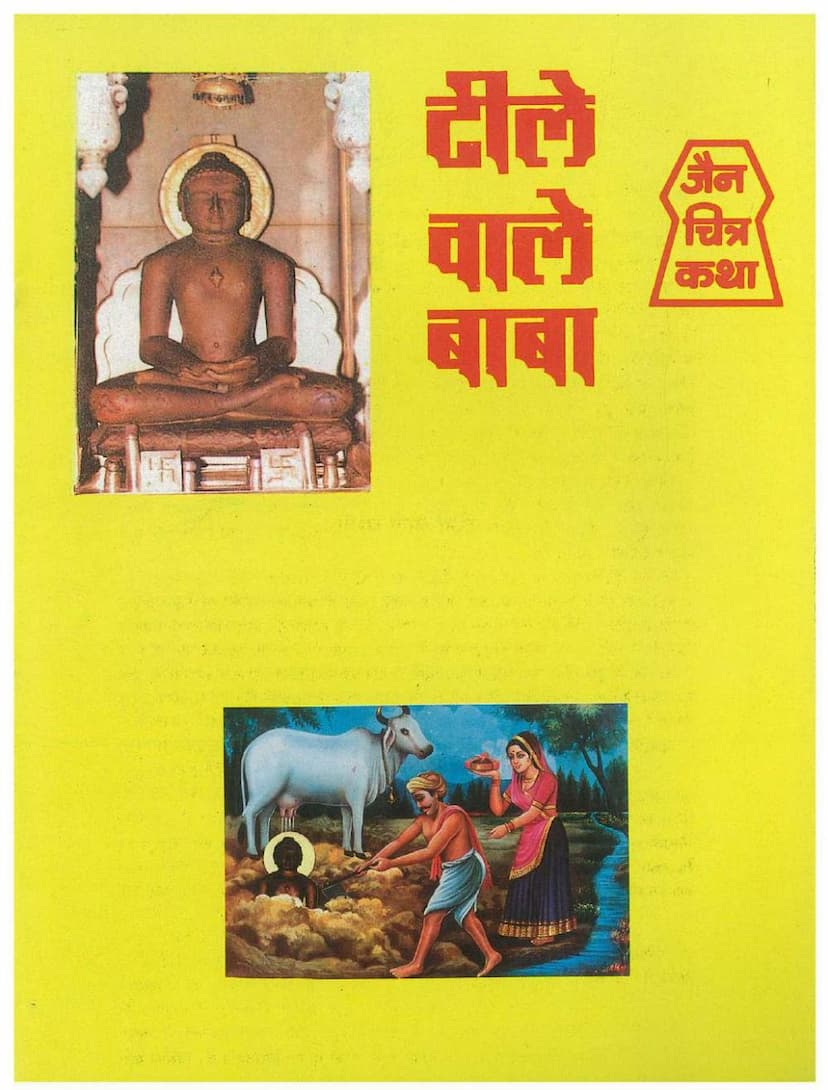Tile Wale Baba
Added to library: September 2, 2025

Summary
Here's a comprehensive summary of the Jain text "Tile Wale Baba" by Mishrilal Jain, based on the provided pages:
The book "Tile Wale Baba" is a Jain story published by Acharya Dharmshrut Granthmala in May 1988. It narrates the miraculous discovery and installation of a statue of Bhagwan Mahavir.
The Discovery of the Statue:
The story begins in the village of Chandanpur, where a cowherd named Chaturā and his wife Lakshmi owned a cow named Dhauri. One day, Chaturā noticed that Dhauri's milk was completely drained after grazing. Confused, he followed the cow and was astonished to see her standing on a mound (tila), with milk flowing from her udders onto the mound spontaneously.
Intrigued, Chaturā decided to dig at the mound. He was warned by a divine voice to dig carefully as there was something precious within. Upon removing the earth, a statue was revealed. The news of the divine discovery spread rapidly, attracting devotees from far and wide. People came with wishes, and stories of their desires being fulfilled through the statue's miracles spread in all directions.
Installation of the Statue:
Amarchand Ji Diwan, a wealthy individual, decided to build a temple for the statue. When he tried to transport the idol on a chariot, it became immobile. It was only when Chaturā, the humble cowherd who had discovered the idol, touched the chariot that it began to move again. The statue was then ceremoniously installed in the temple.
The Significance of the Place and the Story:
The editorial highlights that the temple of "Tile Wale Baba" is located near Chandanpur village. It mentions the immense fame of the Bhagwan Mahavir statue and the divine legend surrounding its discovery. The place is described as an "Atishay Kshetra" (a place of miracles) with several other noteworthy sites, including an ashram of Krishna Bai Ji, a historical glass Jain temple of Parshvanath, and an ideal women's college established by Bra. Kamala Bai Ji. It also mentions Shantiveer Nagar on the eastern bank of the Gamini River, housing a 28-foot tall statue of Shantinath Swami and idols of 24 Tirthankaras and their attending deities.
The Narrative of Bhagwan Mahavir's Life:
The book then delves into a biographical account of Bhagwan Mahavir, likely presented to the readers to educate them about the Tirthankar whose statue was discovered. This section recounts:
- Birth and Parents: Bhagwan Mahavir was born in Vaishali to King Siddhartha and Queen Trishala.
- Fourteen Auspicious Dreams: Queen Trishala had sixteen auspicious dreams, which were interpreted as a sign that she would bear a son who would bring welfare to the world.
- Birth and Early Life: Mahavir's birth was celebrated by humans, deities, and others. He was known by various names like Vardhman, Vir, Sanmati, and Ativeer. He was a strong and fearless child, even facing a demon named Sangam who tested his bravery.
- Marriage and Renunciation: At the appropriate age, Mahavir was married to Princess Yashoda. However, he felt that marriage was like a bondage and wished to renounce the world to attain self-realization and work for the welfare of all beings. Despite his parents' initial reluctance due to him being their only son, they eventually granted him permission to leave home.
- Asceticism and Austerity: Mahavir embraced asceticism and underwent severe penances for twelve years in the Jhalakhand forest, living a life of austerity and detachment.
- Persecution and Endurance: During his travels through villages, towns, and forests, people often threw mud and stones at him, but Mahavir endured these hardships without any resistance.
- Gaining Kevalgyan (Omniscience): He attained Kevalgyan on the banks of the river Rjupalika. A halo of light surrounded his head, signifying his divine knowledge.
- Preaching and Teachings: For thirty years after attaining Kevalgyan, Bhagwan Mahavir preached the path of welfare to the world. His core teachings emphasized compassion for all living beings, helping the poor, and abstaining from violence, falsehood, theft, unchastity, and possession.
- Nirvana: Bhagwan Mahavir attained Nirvana at the age of 72. A radiant light emanated from his body and merged into the sky, and his physical form also disappeared, freeing him from the cycle of birth and death.
The Temple Construction and Social Inclusion:
The story returns to the context of the temple construction. Amarchand Ji, impressed by Chaturā's devotion, initially suggested building the temple. However, Lakshmi, Chaturā's wife, was hesitant, fearing that the deity might become "alien" to them. Amarchand Ji, however, recognized Mahavir as the deity of everyone and promised to build a beautiful temple.
The narrative then depicts the chariot procession to the temple. Millions of Meena and Gujjar devotees participated. When the chariot became immobile, it was realized that Chaturā's consent and participation were crucial for the idol to be moved. Amarchand Ji went to Chaturā, who was saddened by the thought of the deity leaving. Amarchand Ji assured Chaturā and his community that they would not be barred from the temple.
The story culminates with the idol being successfully moved by Chaturā's touch, with women singing songs of devotion and the procession moving towards the temple amidst joyous celebrations. The book concludes with the idol being installed and worshipped at the Digambar Jain temple in Shri Mahavir, Rajasthan, where millions of pilgrims visit annually, acknowledging the statue's miraculous powers.
The book also includes a promotional section for "Jain Chitra Katha" (Jain Picture Stories), emphasizing its role in promoting Jain principles, moral values, and cultural heritage among children and the younger generation through engaging, illustrated stories based on Jain scriptures.